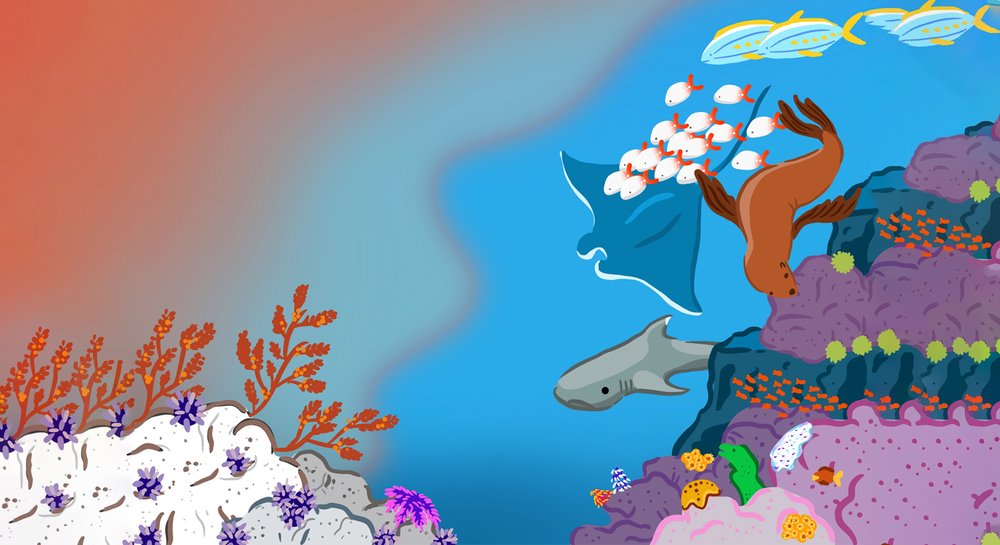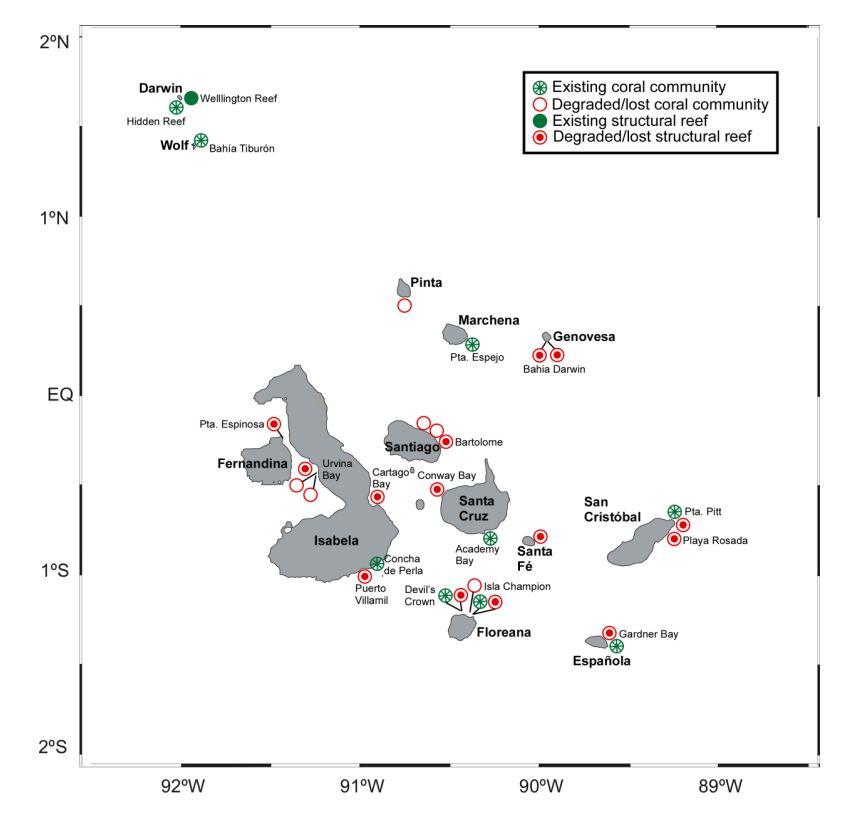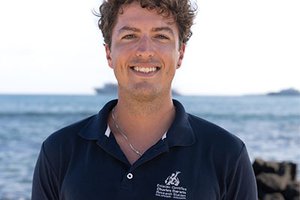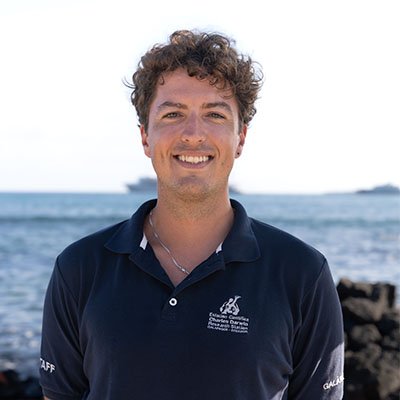The Galapagos was the first place I ever put on the awkward fitting and perhaps slightly oversized SCUBA gear and wetsuit as a young teenager and took my first step into the magnificent underwater world whose doors it opened. Now, over ten years later, that gear no longer feels awkward, and the wetsuit fits like a second skin, the underwater world has become my second home and through my work I aim to do my best to preserve and protect this remote patch of rich marine life in the Eastern Tropical Pacific.

Of all the dive sites I have had the privilege of visiting across the archipelago, there is one that will always keep calling me back and capturing my imagination no matter how many times I return. A stunning coral reef as far as the eye can see, schools of hammerheads swimming past and turtles floating weightlessly in the water unaware of the world moving around them. As you slowly begin to overcome the sensation of awe at seeing all this as soon as you jump in, you can then begin to focus on the second underwater world found closer to the seafloor; brightly coloured reef fish schooling around big heads of coral, morays snaking through small crevasses and multicoloured feathered Christmas tree worms sprouting out from the rock. The name of this magical site? Wellington Reef, just off the coast of Darwin Island, in the far northwest region of the Galapagos Archipelago.
The aforementioned is famous for being the only remaining structural coral reef in the Galapagos Islands, named so after G. M. Wellington (1948 – 2014) who was a pioneer in the efforts to establish marine protected areas in the Galapagos in 1975 and performed the first marine resource surveys of the islands. The reef’s main structure ranges between 12 and 16 metres depth, but corals can be found up to depths of 28 m. It is principally made up of the warmer water Porites lobata coral, reaching a massive 2 to 4 metre heights in some areas, as well as several Pavona spp. and Pocillopora spp. colonies, totalling an incredible 21 recognised zooxanthellate seleractinian, stony coral, species. However, it was not always this way, there were once seventeen structural reefs and communities scattered around the islands, some over 500 years old. But this all changed after 1983.
Prior to the 1982/3 El Niño Southern Oscillation (ENSO) coral habitats in the Galapagos were made up of low diversity coral communities and small coral reefs which were actively accreting, with most falling within the Central-Southeastern bioregion which is protected from the colder upwelling of the Cromwell Current. Nevertheless, there were some established coral reefs in the Western region in areas sheltered from the strong upwelling. This ENSO event brought with it disastrous impacts on both local wildlife, causing several extinctions, and coral reefs across the islands, recording an average of 97% mortality of the latter as well as significant bleaching among the remaining coral populations. In addition, it reduced certain populations of corals, such as Gardineroseris planulata, down to singular isolated patches. After such devastation, it was believed that the existence of coral reef systems in the Galapagos could be at serious risk if not protected properly, especially since the effects were compounded by the incessant grazing from urchins further degrading the corals and preventing their recovery. In fact, of the 17 original coral reefs documented, only one remained after this event, Wellington Reef at Darwin.

Corals then began to recover slowly but any hopes of full restoration were dashed by another extreme ENSO event, comparable in both magnitude and duration, which hit just 14 years later, giving little time for the corals to fully recover and repopulate. Fortunately, this event caused much lower coral mortality than its predecessor, with an average of 26.2% in the Galapagos, although this did reach much higher levels of 72.4% in some areas, as well as causing less bleaching damage to corals at depths greater than 12 metres which was fortunate for our reef located in Darwin. Nevertheless, it still had a significant impact on corals throughout the archipelago, completely reversing coral recovery in many areas and causing several local extirpations like that of G. planulata which could not survive the impact of both events due to its small geographical locality.
Since then, there has been a notable recovery of corals on a few islands, notably Marchena, Wolf and Darwin, however, Darwin’s Wellington Reef remains the only structural coral reef in the entire archipelago (Figure 1) . This claim is supported by recent monitoring undertaken by the Charles Darwin Research Station’s Ecological Monitoring Project team. Therefore, its protection is of the utmost importance to maintain one of the most diverse and spectacular ecosystems supporting life from the biggest creatures like whale and tiger sharks to microscopic hydrozoan. Additionally, it also provides an invaluable sanctuary and nursery for juvenile fish in the region. As climate change worsens, its effects on marine environments, especially isolated ones such as the ones here in the Galapagos, become more severe. ENSO events are also likely to become more frequent and of increased strength, leading to possible further damage to coral reef systems remaining in the archipelago.
Thanks to the collaboration between the Charles Darwin Foundation and the philanthropic engineering organisation Aqualink, the amazing Wellington Reef now has a Spotter + Smart Mooring oceanographic buoy, produced by SOFAR Ocean, which functions as an all-in-one ocean surface weather station as well as having temperature sensors at depths of both 1 and 18 m. This provides us with real-time updates on the conditions currently experienced by the reef, which are open to the public and can be accessed via either of these links: https://spotters.sofarocean.com/historical/SPOT-1161?spotter-filter=SPOT-1161
https://aqualink.org/sites/944
This information is vital for the monitoring and analysis of the coral reef’s health and helps us to better understand the relation between the coral reef’s health and the oceanographic conditions it experiences, as well as changes in coral-algae interactions in the region, hopefully aiding us in managing the long-term survivability of such an important, and now rare, ecosystem here in the Galapagos.
Since the installation of the buoy on the 10th of March 2022, the temperature anomaly at both depths was already around +1°C (+1.8°F) which is already on the universal bleaching threshold for corals, considered to be one degree warmer than the highest monthly mean temperature for that region. Fortunately for the health of the corals, possible localised upwelling helped to reduce the temperature at the coral depth, by bringing up colder waters, until the end of March. However, this was quickly followed by consistently high temperatures, with the exception of a short 3-day period in April, both at depth and at the surface causing a Coral Heat Stress Alert Level 1, at which significant coral bleaching is likely (NOAA). The maximum temperature at the surface over this time was 29.5°C (85.1°F) and the seafloor temperature was not far off at 29.1°C (84.38°F), the former of these being a +3.6°C (+6.48°F) temperature anomaly, well over the bleaching threshold. This is extremely worrying for the health of the corals in this area, and it has likely impacted the coral community located at Wolf Island (Figure 1) nearby as well.
Our aim is to voyage up to the site in the near future and perform a survey of the site, whilst also pausing to take in its beauty one more time, and check on the coral health at both Darwin and Wolf and compare this to surveys undertaken in early March 2022, before this possible bleaching event occurred. Despite the unfortunate news there is some hope. A recent study has suggested that localised upwelling in the northern region encompassing Darwin and Wolf has aided the corals in the area to survive these harsh temperature increases, and we hope this is the case when we go to observe the state of the corals next month. Until then, we will continue to monitor the oceanographic conditions surrounding the coral reef via our Aqualink buoy and hope to expand our capacity to the other remaining coral community sites on islands such as Floreana and Marchena. Helping to protect the diverse and magnificent underwater ecosystem here in the Galapagos is a duty which owe to both the wildlife here and future generations who should also be able to experience its wonders, and the information collected through these
References
Asch, R. G., Cheung, W. W. L. and Reygondeau, G. (2018) ‘Future marine ecosystem drivers, biodiversity, and fisheries maximum catch potential in Pacific Island countries and territories under climate change’, Marine Policy. Pergamon, 88, pp. 285–294. doi: 10.1016/J.MARPOL.2017.08.015.
Doney, S. C., Ruckelshaus, M., Emmett Duffy, J., Barry, J. P., Chan, F., English, C. A., Galindo, H. M., Grebmeier, J. M., Hollowed, A. B., Knowlton, N., Polovina, J., Rabalais, N. N., Sydeman, W. J. and Talley, L. D. (2011) ‘Climate Change Impacts on Marine Ecosystems’, http://dx.doi.org/10.1146/annurev-marine-041911-111611. Annual Reviews , 4, pp. 11–37. doi: 10.1146/ANNUREV-MARINE-041911-111611.
Edgar, G. J., Banks, S. A., Brandt, M., Bustamante, R. H., Chiriboga, A., Earle, S. A., Garske, L. E., Glynn, P. W., Grove, J. S., Henderson, S., Hickman, C. P., Miller, K. A., Rivera, F. and Wellington, G. M. (2010) ‘El Niño, grazers and fisheries interact to greatly elevate extinction risk for Galapagos marine species’, Global Change Biology. John Wiley & Sons, Ltd, 16(10), pp. 2876–2890. doi: 10.1111/J.1365-2486.2009.02117.X.
Edgar, G. J., Banks, S., Fariña, J. M., Calvopiña, M. and Martínez, C. (2004) ‘Regional biogeography of shallow reef fish and macro-invertebrate communities in the Galapagos archipelago’, Journal of Biogeography, 31(7), pp. 1107–1124. doi: 10.1111/j.1365-2699.2004.01055.x.
Feingold, J. S. (2001) ‘RESPONSES OF THREE CORAL COMMUNITIES TO THE 1997–98 EL NIÑO–SOUTHERN OSCILLATION: GALÁPAGOS ISLANDS, ECUADOR’, Bulletin of Marine Science, 69(1), pp. 61–77. Available at: https://nsuworks.nova.edu/cgi/viewcontent.cgi?article=1721&context=occ_facarticles/.
Glynn, P. W. (1988) ‘EL NIÑO—SOUTHERN OSCILLATION 1982-1983: NEARSHORE POPULATION, COMMUNITY, AND ECOSYSTEM RESPONSES’, https://doi.org/10.1146/annurev.es.19.110188.001521. Annual Reviews 4139 El Camino Way, P.O. Box 10139, Palo Alto, CA 94303-0139, USA, 19, pp. 309–346. doi: 10.1146/ANNUREV.ES.19.110188.001521.
Glynn, P. W. (1990) ‘Coral Mortality and Disturbances to Coral Reefs in the Tropical Eastern Pacific’, Elsevier Oceanography Series. Elsevier, 52(C), pp. 55–126. doi: 10.1016/S0422-9894(08)70033-3.
Glynn, P. W. (1994) ‘State of coral reefs in the Galápagos Islands: Natural vs anthropogenic impacts’, Marine Pollution Bulletin. Pergamon, 29(1–3), pp. 131–140. doi: 10.1016/0025-326X(94)90437-5.
Glynn, P. W. (2000) ‘Effects of the 1997-98 El Niño-Southern Oscillation on Eastern Pacific corals and coral reefs: An overview’, Proc. 9th int. coral reef symp., 2, pp. 1169–1174. Available at: http://www.coral.noaa.gov/glynn2. (Accessed: 20 April 2022).
Glynn, P. W., Alvarado, J. J., Banks, S., Cortés, J., Feingold, J. S., Jiménez, C., Maragos, J. E., Martínez, P., Maté, J. L., Moanga, D. A., Navarrete, S., Reyes-Bonilla, H., Riegl, B., Rivera, F., Vargas-Ángel, B., Wieters, E. A. and Zapata, F. A. (2017) ‘Eastern Pacific Coral Reef Provinces, Coral Community Structure and Composition: An Overview’, pp. 107–176. doi: 10.1007/978-94-017-7499-4_5.
Glynn, P. W. and D’Croz, L. (1990) ‘Experimental evidence for high temperature stress as the cause of El Niño-coincident coral mortality’, Coral Reefs. Springer-Verlag, 8(4), pp. 181–191. doi: 10.1007/BF00265009.
Glynn, P. W., Feingold, J. S., Baker, A., Banks, S., Baums, I. B., Cole, J., Colgan, M. W., Fong, P., Glynn, P. J., Keith, I., Manzello, D., Riegl, B., Ruttenberg, B. I., Smith, T. B. and Vera-Zambrano, M. (2018) ‘State of corals and coral reefs of the Galápagos Islands (Ecuador): Past, present and future’, Marine Pollution Bulletin. Elsevier Ltd, 133, pp. 717–733. doi: 10.1016/j.marpolbul.2018.06.002.
Glynn, P. W., Maté, J. L., Baker, A. C. and Calderón, M. O. (2001) ‘CORAL BLEACHING AND MORTALITY IN PANAMA AND ECUADOR DURING THE 1997-1998 EL NINO-SOUTHERN OSCILLATION EVENT: SPATIAL/TEMPORAL PATTERNS AND COMPARISONS WITH THE 1982-1983 EVENT’, Bulletin of Marine Sciencet, 69(1), pp. 79–109. Available at: https://repository.si.edu/bitstream/handle/10088/11920/stri_Glynn_Mate_Baker_Calderon.pdf.
Glynn, P. W., Riegl, B., Purkis, S., Kerr, J. M. and Smith, T. B. (2015) ‘Coral reef recovery in the Galápagos Islands: the northernmost islands (Darwin and Wenman)’, Coral Reefs 2015 34:2. Springer, 34(2), pp. 421–436. doi: 10.1007/S00338-015-1280-4.
NOAA (2022) NOAA Coral Reef Watch Homepage and Near Real-Time Products Portal. Available at: https://coralreefwatch.noaa.gov/index.php (Accessed: 22 April 2022).
Riegl, B., Glynn, P. W., Banks, S., Keith, I., Rivera, F., Vera-Zambrano, M., D’Angelo, C. and Wiedenmann, J. (2019) ‘Heat attenuation and nutrient delivery by localized upwelling avoided coral bleaching mortality in northern Galapagos during 2015/2016 ENSO’, Coral Reefs 2019 38:4. Springer, 38(4), pp. 773–785. doi: 10.1007/S00338-019-01787-8.
Robinson, G. (1985) ‘Influence of the 1982–83 El Niño on Galápagos marine life’, El Niño en las Islas Galápagos: El Evento de 1982-1983, pp. 153–190.
Tsonis, A. A., Hunt, A. G. and Elsner, J. B. (2003) ‘On the relation between ENSO and global climate change’, Meteorology and Atmospheric Physics, 84(3–4), pp. 229–242. doi: 10.1007/S00703-003-0001-7.
Vinueza, L. R., Branch, G. M., Branch, M. L. and Bustamante, R. H. (2006) ‘TOP-DOWN HERBIVORY AND BOTTOM-UP EL NIÑO EFFECTS ON GALÁPAGOS ROCKY-SHORE COMMUNITIES’, Ecological Monographs. John Wiley & Sons, Ltd, 76(1), pp. 111–131. doi: 10.1890/04-1957.
Wellington, G. M. (1975) The Galapagos coastal marine environments: a resource report to the Department of national parks and wildlife. Quito.







